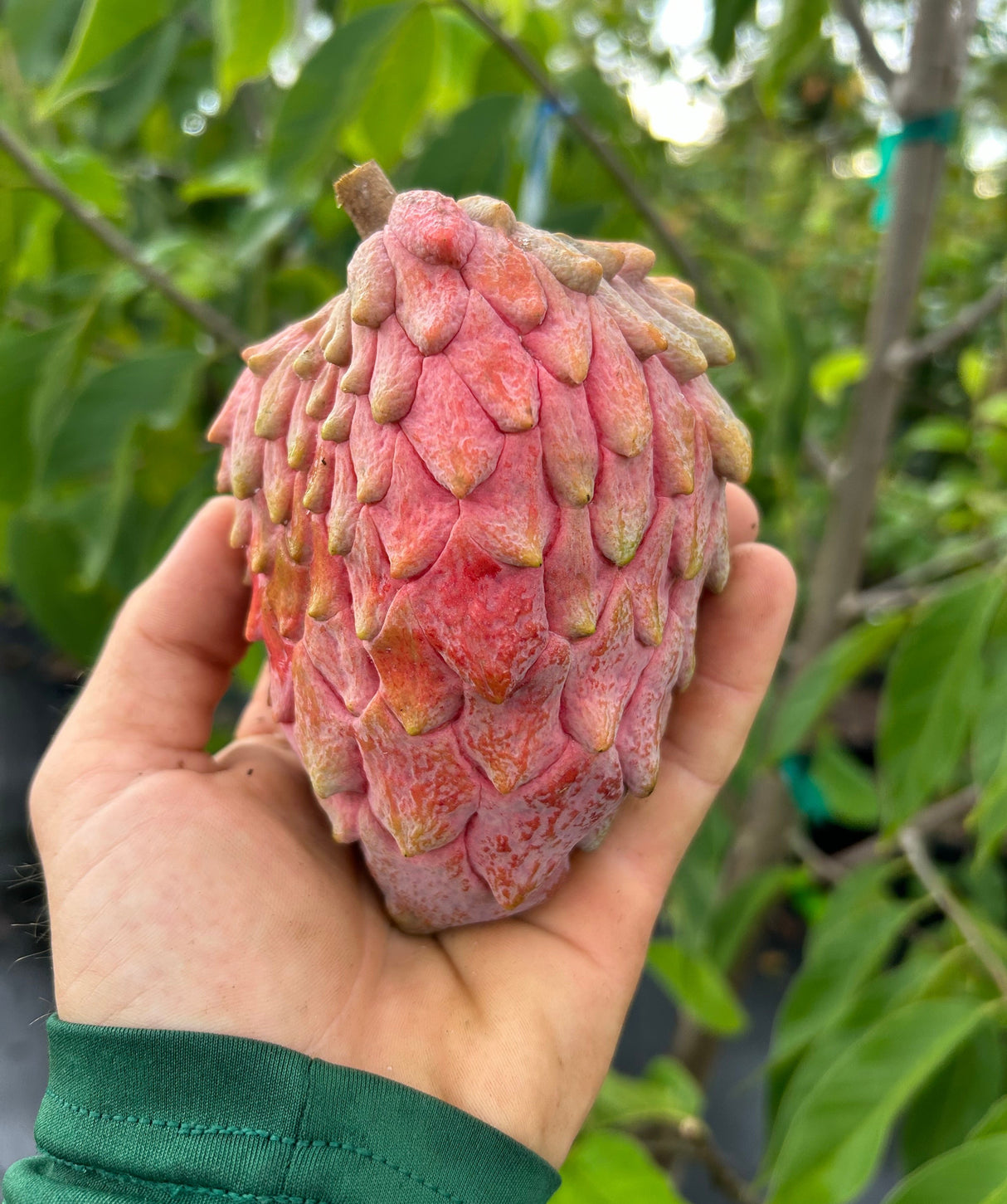Temoylata Tree 'Red Geffner'
Temoylata Tree 'Red Geffner' - 3 Gallon is backordered and will ship as soon as it is back in stock.
Fruit Tree Pot Size Reference Guide
Fruit Tree Pot Size Reference Guide
Display general product information or specific product information using metafields.
We sell grafted fruit trees in various sizes, ranging from young 3-gallon plants all the way up to 25-gallon and larger, mature trees.
As a general rule of thumb, here’s what you can expect from each size:
3 gallon: Will take an average of 2-3 years before harvesting your first crop. Trees are small and may be just a single stem, or just starting to develop their first branches. Typical height is between 2-4 feet.
7 gallon: Will take an average of 1–2 years to produce a crop. Branching structure has started to develop, and trunks are between ½ to 1 inch thick. Typical height is between 3-6 feet.
15 gallon: You can usually expect fruit within a year of planting, and some trees are already fruiting at this size. Branch and canopy structure has taken shape and the tree is starting to grow wider. Trunks are between 1 to 1-½ inches thick. Typical height is 5-8 feet.
25 gallon and larger: These are mature trees, and most are ready to produce fruit or have already produced. They have been pruned and shaped multiple times at this point. Trunks are about 2” thick or larger. Typical height is 6-10 ft.
PLEASE NOTE: These descriptions are generalized - Some species of fruit trees are very quick to produce, and others take longer. For example, mulberry trees can start fruiting at a very young age, even as small as a 3 gallon. Mango, avocado, or sapodilla trees will take longer. Each species grows at a different rate and will take varying lengths of time to establish, and even different cultivars can be more precocious (quick to produce) than others.
Order Pick Up Info
Order Pick Up Info
When you select the “Nursery Pickup” option at checkout, please allow up to 24-48 hours for your order to be prepared for pickup. Once your order is ready for pickup, we will email you to let you know that it is ready. Plant orders may be held at the nursery for up to 10 days. If orders are not picked up within this time frame, a 15% restocking fee will be charged. If you are unable to pick up your order, please contact us to request a quote for delivery.
Responsibility of Care
Responsibility of Care
Return Policy
Return Policy
Inventory Disclaimer
Inventory Disclaimer
Every day, we take great care to maintain our inventory and make real-time updates as plants come and go. Because our inventory is constantly changing, and because in-store and online purchases are being made simultaneously, it is possible for a short window to occur when an item is physically sold out, but listed as in-stock on this platform. This is rare, but in the case that it does happen, we will contact you right away and either refund the item or offer an alternative. Thank you for your understanding!
Additionally, we add new plants to the nursery on a weekly, sometimes daily basis. Check back often to see what’s in stock, and click the “Notify me when this item is available” button to get updates when your wish-list items are restocked!
Description
Description
Latin name - Atemoya x reticulata
Temoylata is yet another exciting hybridization of two Annona species, the atemoya and the custard apple. (Atemoya x reticulata). Since the atemoya is itself already a hybrid, the Temoylata would be considered a complex hybrid, containing genetics from 3 distinct Annona fruits: Cherimoya x Sugar Apple x Custard Apple. To those who aren’t seasoned botanists and may be uneasy with the terminology, don’t be alarmed! Hybridization is a natural process of plant breeding which commonly occurs through insect activity. Bees or other pollinating insects move pollen from one flower to another, and if viable seeds are formed within the resulting fruit, a hybrid has been created. Humans can also help create hybrids by planting desirable parent trees close together, transferring pollen from one to another, and evaluating their offspring. If hybridization produces a new and unique fruit with good qualities, it’s a success!
Strap yourself in, the fruit nerd-ing has only just begun:
The specific Temoylata that we grow is more commonly known by the names “Red Geffner” and “Red Atemoya”, although these are slight misnomers since it’s not an atemoya.
The shortest and most accurate way to refer to it is by its field number “47-18”. How enticing!
Temoylata 47-18 was a product of Annona expert Har Mahdeem’s hybridization efforts in the mid-90’s, under the Zill breeding projects. Its two parents are the ‘Geffner’ atemoya and ‘San Pablo’ custard apple. 47-18 is the field planting number– this hybrid was never given a formal name or used commercially by Zill. We are not quite sure why, as the tree has many desirable qualities: it grows vigorously in South FL’s climate, is precocious, and the fruit is impressive both visually and in flavor. Somehow the tree fell into obscurity, but thanks to a handful of collectors who obtained budwood, the 47-18 Temoylata has survived and is now gaining popularity. We found out about it several years ago when Miami Fruit began selling the fruit under the name “Red Atemoya”, for upwards of $170 for a single fruit!
Needless to say, the Temoylata is an interesting part of our Annona collection and stands as a stunning example of the possibilities of fruit breeding, particularly within the Annona family.
___________________________________________________________________________
Size: 8-10’ wide x 12-15’ tall, with pruning
Sun Requirements: Full sun
Cold Hardy: 28 degrees
Harvest Season: Late summer
Watering requirements: Fairly drought tolerant once established
Food Forest Layer: Canopy, Understory




